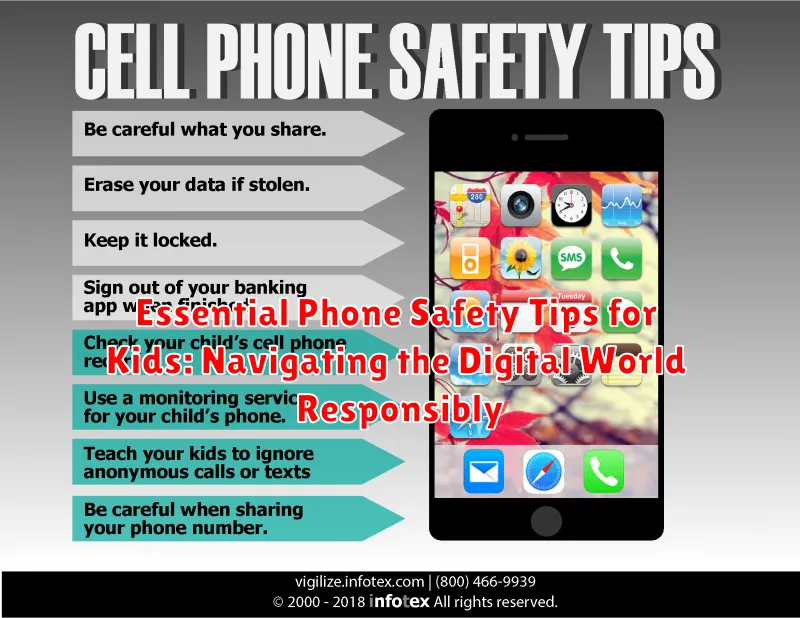In today’s digitally driven world, children are increasingly exposed to technology at a younger age. While the internet offers incredible learning opportunities and connectivity, it also presents potential risks. It is essential for parents and guardians to equip their children with the knowledge and skills to navigate the digital landscape safely and responsibly. This article outlines essential phone safety tips for kids, covering topics such as responsible online behavior, managing screen time, protecting personal information, and recognizing and avoiding online threats like cyberbullying and inappropriate content. By understanding these phone safety tips, children can harness the power of technology while mitigating potential harms.
These essential phone safety tips for kids provide a framework for fostering responsible digital citizenship. We will delve into strategies for establishing clear expectations regarding phone usage, creating open communication channels about online experiences, and empowering kids to make informed decisions in the digital realm. This guidance will help parents and caregivers ensure their children can enjoy the benefits of technology while safeguarding their well-being and promoting healthy online habits. The goal is to empower kids to be confident, responsible, and safe digital explorers.
Understanding the Risks and Benefits of Kids Having Phones
Providing a child with a cell phone presents both advantages and potential hazards. It’s crucial for parents to carefully weigh these factors before making a decision. A phone can offer a sense of security, allowing children to contact family in emergencies. It can also be a valuable tool for learning and social connection.
However, risks exist. Unrestricted internet access can expose children to inappropriate content, cyberbullying, and online predators. Overuse can lead to addiction, sleep disruption, and difficulties with focus and attention in school. Sharing personal information online carries privacy risks. Furthermore, the constant connectivity can hinder the development of essential social skills and face-to-face communication abilities.
Establishing Clear Rules and Expectations for Phone Usage
A family phone contract can be a valuable tool. This written agreement outlines the rules and expectations for phone usage, creating a clear understanding between parent and child. Collaboratively establishing these rules fosters a sense of responsibility.
Time limits are essential. Define specific times for phone usage, such as after homework or chores, and restrict usage during family time, meals, and bedtime. Weekday and weekend schedules may differ.
Designated “phone-free” zones in the house, such as bedrooms or the dinner table, can minimize distractions and promote face-to-face interactions.
App usage restrictions are also important. Set clear guidelines on which apps are permitted and appropriate for your child’s age. Consider limiting access to social media platforms or games with in-app purchases.
Charging the phone outside the bedroom at night helps ensure healthy sleep habits and discourages late-night phone usage.
Teaching Kids about Responsible Online Behavior (Cyberbullying, Privacy, Sharing Information)
Cyberbullying is a serious issue. Teach your child to never engage in hurtful online behavior, such as sending mean messages, spreading rumors, or excluding others. Emphasize the importance of empathy and treating others online as they would in person. Encourage them to report any instances of cyberbullying they witness or experience.
Online privacy is crucial. Explain to your child why it’s important to keep personal information private, like their full name, address, phone number, and school name. Stress that they should never share this information with strangers online.
Discuss responsible information sharing. Explain the potential consequences of sharing photos and videos without permission. Educate them about the permanence of online content and how things shared online can stay there forever. Emphasize the importance of thinking before posting and considering the potential impact on themselves and others.
Teach your child to be mindful of what they share about others. Sharing photos or videos of friends or family without their consent can be hurtful and a violation of their privacy.
Using Parental Control Apps and Features Effectively

Parental control apps and built-in phone features offer a powerful way to manage your child’s digital experience. These tools can provide a safety net, allowing you to set healthy boundaries and protect your child from potential online dangers. Research different apps and compare their features to find one that aligns with your family’s needs.
Many parental control apps allow you to manage screen time, limiting the hours your child can spend on certain apps or the phone altogether. This can help prevent excessive phone use and encourage a healthy balance with offline activities. You can also filter content, blocking access to inappropriate websites, apps, and games based on age ratings or specific categories.
Location tracking features available in some apps and devices can provide added peace of mind, enabling you to monitor your child’s whereabouts. Some apps even allow you to set geofences, receiving alerts if your child enters or leaves designated areas. Remember to discuss these features with your child to foster open communication and trust.
Most smartphones have built-in parental control options, offering basic features like content restrictions and app limits. Explore these settings and utilize them in conjunction with or as an alternative to dedicated apps.
Monitoring Your Child’s Phone Activity and Online Interactions
Regularly monitoring your child’s phone activity and online interactions is crucial for ensuring their safety and well-being in the digital world. This doesn’t imply a lack of trust, but rather provides a safety net and opportunities for guidance.
Openly discuss your monitoring practices with your child. Explain that it’s about safety and responsible digital citizenship, not invasion of privacy. This transparency fosters trust and understanding.
Utilize available parental control features to track app usage, website visits, and communication frequency. Be aware of the apps your child uses and who they are interacting with online. Look for any sudden changes in behavior or communication patterns that might indicate a problem.
Periodically review their text messages and social media activity. Look for signs of cyberbullying, inappropriate content, or interactions with strangers. Encourage your child to show you interesting things they find online, fostering open communication and allowing you to guide their digital exploration safely.
Establish clear guidelines about acceptable online behavior and the consequences of violating those rules. Consistent monitoring, coupled with open communication, creates a safe and supportive environment for your child’s digital journey.
Educating Kids about Online Scams and Phishing Attempts
The digital world unfortunately exposes children to online scams and phishing attempts. It’s crucial to equip them with the knowledge to identify and avoid these threats. Explain that scams are tricks to steal information or money. Phishing, a specific type of scam, uses deceptive messages, like fake emails or texts, pretending to be from legitimate sources.
Teach children to be wary of messages requesting personal information like passwords, bank details, or social security numbers. Emphasize that legitimate organizations rarely ask for these details online. Highlight the importance of checking the sender’s address carefully and looking for misspellings or unusual characters, which are often signs of a phishing attempt.
Encourage your child to question anything that seems too good to be true, like winning a prize they didn’t enter. Instill the habit of verifying offers independently by contacting the supposed organization directly through official channels. Finally, explain the importance of reporting suspicious messages to you and the relevant authorities.
Open Communication and Building Trust

Perhaps the most critical aspect of children’s phone safety is fostering open communication and building a foundation of trust. Children should feel comfortable discussing their online experiences, both positive and negative, without fear of judgment or punishment. This open dialogue is crucial for identifying potential risks and addressing issues before they escalate.
Encourage your child to share anything that makes them feel uncomfortable, confused, or scared online. Emphasize that you are there to support and guide them, not to scold or restrict. Actively listen to their concerns and validate their feelings. This approach creates a safe space for them to confide in you and seek help when needed.
Regularly check in with your child about their online activities, but avoid interrogating them. Frame your inquiries as genuine interest in their digital world. Ask open-ended questions about their favorite apps, games, and online friends. This shows your child that you value their online life and encourages ongoing communication.
By fostering open communication and mutual trust, you empower your child to navigate the digital landscape responsibly and safely while strengthening your parent-child relationship.

